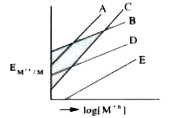Nernst equation gives the variation of potential of an electrode based on activity of ions temperature and pressure. The equation is
E=E∘−2.303RTnFlogQ(or)E=E∘−0.0591nlogQ
E∘= Standard potential and 'Q' is the reaction quotient.
What is the reduction potential of a hydrogen electrode in an aqueous solution containing 0.1 M NH4OH,(Kb=10−5), ? Solution in Telugu
0.02 V
0.03 V
0.06 V
0.01 V
The correct Answer is:A
E1=E0+0.063logC,E2=E0+0.063log(C10)
(E2−E1)=0.063[log(C60)−logC]=0.02log(C10×1C)=0.02×log10−1=−0.02V
Topper's Solved these Questions
- BOOK - AAKASH SERIESCHAPTER - ELECTROCHEMISTRY EXERCISE - PRACTICE SHEET -5 (LINKED COMPREHENSION TYPE QUESTIONS (PASSAGE-II))3videos
ELECTROCHEMISTRY
- BOOK - AAKASH SERIESCHAPTER - ELECTROCHEMISTRY EXERCISE - PRACTICE SHEET -5 (MATCH THE FOLLOWING QUESTIONS )2videos
ELECTROCHEMISTRY
- BOOK - AAKASH SERIESCHAPTER - ELECTROCHEMISTRY EXERCISE - PRACTICE SHEET -5 (SINGLE OR MORE THAN ONE OPTION QUESTIONS)16videos
ELECTROCHEMISTRY
- BOOK - AAKASH SERIESCHAPTER - DILUTE SOLUTIONSEXERCISE - EXERCISE - 1.255videos
DILUTE SOLUTIONS
- BOOK - AAKASH SERIESCHAPTER - ELEMENTS OF D - BLOCKEXERCISE - EXERCISE - 5.233videos
ELEMENTS OF D - BLOCK
Similar Questions
For metal electrodes show the variation in their reduction potential as shown.

Which is the most reactive metal ?00:37View SolutionMatch the following questions
 08:14View Solution
08:14View SolutionThe E∘ at 25∘C for the following reaction at the indicated concentrations is 1.50 V . Calculate the ΔG in kJ at 25∘C,Cr(s)+3Ag+(aq.0.1M)→Ag(s)+Cr3+(aq.0.1M)
04:52View SolutionWhat are the factor on-which solubility depends on ?
View SolutionGive some examples for the ions with pseudo inert gas electronic configuration.
02:03View SolutionElectrode potential for the electrode Mn+∣M with concerntration is given by the expression under STP conditions :
E=Ec−+0.059nlog[Mn+]View Solutionमानक इलेक्ट्रोड विभव क्या हैं। इलेक्ट्रोड विभव ( E ) तथा मानक इलेक्ट्रोड विभव (E∘) में सम्बन्ध लिखिए।
07:18View SolutionThe name of equation showing relation between electrode potential (E) standard electrode potential (E^(@)) and concentration of ions in solution is
04:52View SolutionThe reduction electrode potential E , or 0.1 M solution of M^(+) ions ( E_(RP)^(@) = -2.36 V) is
View SolutionThe reduction electrode potential E of 0.1 M solutoin of M^(+) "ions" (E_(RP)^(@)=-2.36 V) is
02:37View SolutionIf the standard electrode potential (E∘) of a metal is ______ and ______ the metal is a powerful reducting agent .
03:28View SolutionWrite Nernst equation for electrode potential for the following electrodes :
(b) Fe2+→Fe3++e03:10View SolutionWhich equation gives relation between concentration of ions in solution , electrode potential (E) and standard electrode potential (E∘?)
03:38View SolutionWhich equation shows the relation between electrode potential (E ) standard electrode potential (E∘) and concentration of ions in solution is ……………….. .
View SolutionNernst equation gives the variation of potential of an electrode based on activity of ions temperature and pressure. The equation is E=E^(@) -(2.303RT)/(nF) logQ (or) E=E^@ - (0.0591)/(n) log Q E^@ = Standard potential and 'Q' is the reaction quotient. What is the reduction potential of a hydrogen electrode in an aqueous solution containing 0.1 M NH_4OH,(Kb=10^(-5)) , ?
04:05View SolutionNernst equation gives the variation of potential of an electrode based on activity of ions temperature and pressure. The equation is E=E^(@) -(2.303RT)/(nF) logQ (or) E=E^@ - (0.0591)/(n) log Q E^@ = Standard potential and 'Q' is the reaction quotient. Which cell has least potential ?
01:51View Solution

